|
 Secure Site
Secure Site
|
 |
Archive for the 'mindfulness practice' Category
 Meditation Using a magnetic resonance imaging (MRI) machine, Eileen Luders, a re-searcher in the Department of Neurology at the University of California Los Angeles School of Medicine, looks for evidence that meditation changes the physical structure of the brain. Until recently, this idea would have seemed absurd. “Scientists used to believe that the brain reaches its peak in adulthood and doesn’t change—until it starts to decrease in late adulthood,” Luders says. “Today we know that everything we do, and every experience we have, actually changes the brain.” Indeed, Luders finds several differences between the brains of meditators and nonmeditators. In a study published in the journal NeuroImage in 2009, Luders and her colleagues compared the brains of 22 meditators and 22 age-matched nonmeditators and found that the meditators (who practiced a wide range of traditions and had between 5 and 46 years of meditation experience) had more gray matter in re-gions of the brain that are important for attention, emotion regulation, and mental flexibility. Increased gray matter typically makes an area of the brain more efficient or powerful at processing information. Luders believes that the increased gray matter in the meditators’ brains should make them better at controlling their attention, managing their emotions, and making mindful choices.
Why are there differences between the brains of meditators and nonmeditators? It’s a simple matter of training. Neuroscientists now know that the brain you have today is, in part, a reflection of the demands you have placed on it. People learning to juggle, for example, develop more connections in areas of the brain that anticipate moving objects. Medical students undergoing periods of intense learning show similar changes in the hippocampus, an area of the brain important for memory. And mathematicians have more gray matter in regions important for arithmetic and spatial reasoning.
 Meditation Timers and Alarm Clocks - Boulder, CO More and more neuroscientists, like Luders, have started to think that learning to meditate is no different from learning mental skills such as music or math. Like anything else that requires practice, meditation is a training program for the brain. “Regular use may strengthen the connections between neurons and can also make new connections,” Luders explains. “These tiny changes, in thousands of connections, can lead to visible changes in the structure of the brain.” Those structural changes, in turn, create a brain that is better at doing whatever you’ve asked it to do. Musicians’ brains could get better at analyzing and creating music. Mathematicians’ brains may get better at solving problems. What do meditators’ brains get better at doing? This is where it gets interesting: It depends on what kind of meditation they do.
Over the past decade, researchers have found that if you practice focusing attention on your breath or a mantra, the brain will restructure itself to make concentration easier. If you practice calm acceptance during meditation, you will develop a brain that is more resilient to stress. And if you meditate while cultivating feelings of love and compassion, your brain will develop in such a way that you spontaneously feel more connected to others.
Improve Your Attention
New research shows that meditation can help you improve your ability to concentrate in two ways. First, it can make you better at focusing on something specific while ignoring distractions. Second, it can make you more capable of noticing what is happening around you, giving you a fuller perspective on the present moment.
Some of the most fascinating research on how meditation affects attention is being conducted by Antoine Lutz, PhD, an associate scientist at the Waisman Laboratory for Brain Imaging and Behavior at the University of Wisconsin at Madison, in collaboration with Richard Davidson and the Laboratory for Affective Neuroscience at the University of Wisconsin. Their work has shown that concentration meditation, in which the meditator focuses complete attention on one thing, such as counting the breath or gazing at an object, activates regions of the brain that are critical for controlling attention. This is true even among novice meditators who receive only brief training. Experienced meditators show even stronger activation in these regions. This you would expect, if meditation trains the brain to pay attention. But extremely experienced meditators (who have more than 44,000 hours of meditation practice) show less activation in these regions, even though their performance on attention tasks is better. The explanation for this, in Lutz’s view, is that the meditation training can eventually help reduce the effort it takes to focus your attention. “This would be consistent with traditional accounts of progress in meditation practice. Sustaining focus becomes effortless,” Lutz says. This suggests that people can immediately enhance concentration by learning a simple meditation technique, and that practice creates even more progress.
The researchers also looked at whether vipassana meditation training can improve overall attention. (Vipassana means “to see things as they really are,” and the meditation techniques are designed to increase focus, awareness, and insight.) Researchers label our inability to notice things in our environment as “attentional blink.” Most of us experience this throughout the day, when we become so caught up in our own thoughts that we miss what a friend says to us and have to ask her to repeat it. A more dramatic example would be a car accident caused by your thinking about a conversation you just had and not noticing that the car in front of you has stopped. If you were able to reduce your attentional blink, it would mean a more accurate and complete perception of reality—you would notice more and miss less.
 Time Your Meditation With A Zen Timepiece with Tibetan Singing Bowl To test whether meditation reduces attentional blink, participants had to notice two things occurring in rapid succession, less than a second apart. The findings, published in PLoS Biology, reveal that the meditation training improved the participants’ ability to notice both changes, with no loss in accuracy.
What explained this improvement? EEG recordings—which track patterns of electrical activity in the brain, showing precise moment-by-moment fluctuations in brain activation—showed that the participants allocated fewer brain resources to the task of noticing each target. In fact, the meditators spent less mental energy no-ticing the first target, which freed up mental bandwidth for noticing what came next. Paying attention literally became easier for the brain.
As a result, Lutz and his colleagues be-lieve that meditation may increase our control over our limited brain resources. To anyone who knows what it’s like to feel scattered or overwhelmed, this is an ap-pealing benefit indeed. Even though your attention is a limited resource, you can learn to do more with the mental energy you already have.
Our Zen Timepiece’s acoustic 6-inch brass bowl-gong clock is the world’s ultimate alarm clock, practice timer, and “mindfulness bell.” It fills your environment with beautifully complex tones whenever it strikes. In the morning, its exquisite sounds summon your consciousness into awakening with a series of subtle gongs that provide an elegant beginning to your day. Once you experience the Zen Timepiece’s progressive awakening, you’ll never want to wake up any other way. It also serves as the perfect meditation timer.
adapted from Yoga Journal, by Kelly McGonigal
 - Meditation Timers and Gentle Alarm Clocks
Now & Zen’s Meditation Timer Shop
1638 Pearl Street
Boulder, CO 80302
(800) 779-6383
Posted in intention, Meditation Timers, Meditation Tools, mindfulness practice, Now & Zen Alarm Clocks, zen, Zen Timers
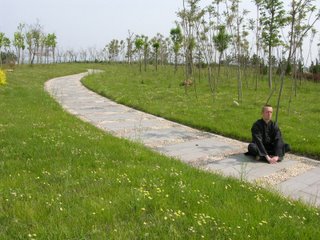 downtime I’m not great with downtime. In line at the post office, I whip out my cell phone and delete old text messages. When I’m stopped at a light, I retrieve a cloth from the glove compartment and dust the dashboard.
At home, I try to snuggle with my pug and relax, but I can’t. I get up to unload the dishwasher, check my e-mail, sort socks, or get a jump on tomorrow’s research and writing. Clearly, I feel better ticking items off my to-do list. The question is: Would I be better off just letting my mind drift?
Truth is, the urge to occupy idle time is tough to fight. We’re a nation of doers, after all: bustling workaholics who have a hard time sitting still (unless it’s in front of the TV). As much as we try to crowd it out, however, experts tell us that boredom is an essential part of the human experience. It’s a counterbalance to all that busyness. In fact, some argue it’s a gateway to peace.
“Create space in your life,” says Body+Soul life coach Cheryl Richardson, “and you’ll find serenity and inspiration on the other side.”
If a little thumb-twiddling can truly lead to better things, why do many of us so desperately avoid it? To demystify our aversion to idleness, we asked Richardson and psychotherapist Richard Winter, M.D., to explain what’s fueling our discomfort with those frightfully unscheduled moments. Here, they share the top three reasons we’re so down on downtime, as well as offer up ways to embrace it — and find deeper satisfaction in the everyday.
We’re Overstimulated
Remember when the doctor’s waiting room was just that — a place to sit, with nothing to do but wait? Now, with TV screens popping up in medical offices, taxicabs, elevators, and even the checkout line (not to mention the lure of your cell phone, iPod, and BlackBerry), every spare moment provides another opportunity for stimulation. As a result, the empty pockets of time we once took for granted have vanished.
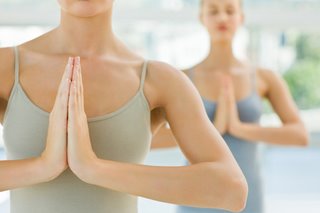 schedule downtime The problem with overstimulation, says Winter, author of “Still Bored in a Culture of Entertainment,” is it creates a “psychological callus” that hardens over time and can eventually keep us from responding with depth to anything or anyone. “Because we can’t discriminate between so many options, we completely shut down our attention to almost everything.”
That, he argues, essentially leaves us feeling passive and craving temporary relief from boredom. Worse, we end up with no time to reflect on our lives, making it harder to forge meaningful connections with the people around us.
Find joy in the humdrum. Recharge your inner resources by reacquainting yourself with quiet. This can prove surprisingly hard if you’re used to nonstop stimulation, so aim for specific actions. Turn off the TV after a certain time each evening. Drive one way of your commute without listening to NPR.
Better still, take a calming walk three nights a week after dinner — and leave the iPod home. The physical activity will satisfy your need to do something, all while energizing you in a way that watching Law & Order can’t. By welcoming a little idle time and its attendant reflection, says Winter, you’ll soon come to “delight in the ordinary again.”
adapted from Body + Soul October 2008
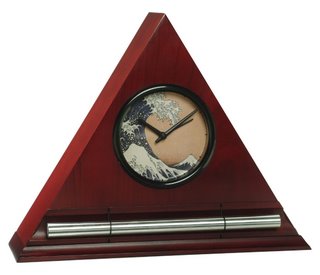 Zen Clock for Timing your downtime with a gentle chime Now & Zen’s Alarm Clock Shop
1638 Pearl Street
Boulder, CO 80302
(800) 779-6383
Posted in intention, Meditation Timers, Meditation Tools, mindfulness practice, nature, Now & Zen Alarm Clocks, Walking Meditation, Well-being, Zen Timepiece by Now & Zen, Zen Timers
 how to have get more energy When it comes to cultivating energy, you probably never did it better than when you were a toddler. You’d come barreling out of bed in the morning, eyes wide and arms full of toys. These days, you’re lucky if you can rouse yourself with multiple alarm clocks and a few cups of coffee. Snacks, if you have time to eat them, aren’t the healthy kind. As for naps and early bedtimes, they happen on rare, unplanned occasions, usually when you’re down with a cold or flu, or exhausted from running yourself ragged all week. With habits like these, it’s no wonder that more than one-third of Americans say they’re so tired that it interferes with work.
Depleted energy interferes with our lives. Feeling energetic “means having the vitality to do the things you want to do,” says Mark Hyman, M.D., editor-in-chief of the journal Alternative Therapies in Health and Medicine and author of “UltraMetabolism.” That vitality isn’t just a state of mind — it’s a physical condition. Each of our cells contains hundreds of mitochondria, tiny “power plants” that combine the oxygen we breathe with the food we eat and then burn the combination to create energy.
 increase vitality with a mindfulness practice We know this process as metabolism. How energetic we feel largely depends on how well our mitochondria are functioning. To function optimally, they need quality fuel: a wholesome, varied diet, restorative sleep, and plenty of oxygen from regular exercise. But rather than enhance our vitality, we often sabotage it with “counterfeit energy” — stimulants like caffeine that we think give us more pep but only drain our energy in the long run.
Getting your energy back is possible. Start by simply looking at your day. From morning until night, energy leaks abound. These daily habits may seem perfectly innocent, but over time they impair your body’s vitality.
Waking up in the morning should be as pleasant as falling asleep at night. The Zen Alarm Clock’s gradual, gentle awakening is transformative.
The Walnut Digital Zen Clock’s long-resonating Tibetan bell-like chime makes waking up a beautiful experience – its progressive chimes begin your day with grace. When the clock’s alarm is triggered, the acoustic chime bar is struck just once … 3-1/2 minutes later it strikes again … chime strikes become more frequent over 10 minutes … eventually striking every 5 seconds until shut off. As they become more frequent, the gentle chimes will always wake you up – your body really doesn’t need to be awakened harshly, with a Zen Clock you’re awakened more gradually and thus more naturally. Unlike artificial recorded sounds coming out of a tiny speaker in a plastic box, natural acoustic sounds transform your bedroom or office environment.
adapted from Body + Soul, September 2006
 gentle wake up clock with chime
Now & Zen’s Chime Alarm Clock Store
1638 Pearl Street
Boulder, CO 80302
(800) 779-6383
Posted in intention, Meditation Timers, Meditation Tools, mindfulness practice, sleep, Sleep Habits, wake up alarm clock, Well-being
 can yoga help you fall asleep? If you’re one of the millions of sleep-starved Americans with a dwindling supply of fence-jumping sheep, try introducing a few Downward Dogs to your bedtime menagerie. A recent clinical study at Boston’s Brigham and Women’s Hospital confirmed that bedtime yoga can help chronic insomniacs significantly reduce their tossing-and-turning time.
The results are most likely linked to yoga’s soothing effect on the central nervous system, says lead study author Sat Bir Khalsa, Ph.D., assistant professor at Harvard Medical School. In insomniacs, levels of the stress hormone cortisol are elevated,” he explains. Yoga can reduce cortisol levels, which is why you have that feeling of calm after practicing it.” And while the study’s poses were selected for their sleep-promoting effects (see below for instructions), Khalsa says most types of yoga, practiced regularly at any time of day, should bring on more nighttime ZZZs. Sleep-promoting yogic breathing exercises
 yoga exercises for insomnia Exercise 1
Sit with a straight spine, with your head erect and chin lightly tucked in. Extend both arms up to form a 60-degree angle (almost vertical), with wrists straight and palms and fingers extended flat and facing up. Keep elbows straight. Begin slow deep breathing through the nose. As you inhale, let your abdomen extend out as though it were being filled with air. As the inhale continues, let your chest expand. At the end of the inhale, pause briefly with your breath suspended; do not to lock your throat to hold the breath, but rather suspend the breath by lifting and suspending the motion of the chest. As you start to exhale, let the chest contract first. As the exhale continues, pull in your abdomen slightly as though it were being emptied of air. Pause briefly at the end of the exhale before beginning the next inhale. The breath rate should be four breaths per minute or slower (15 seconds or longer for each complete inhale/exhale). It is important that this breath, as with all of the breathing in these exercises, is done through the nose. Keep your eyes closed during this exercise, and focus your mental attention on the flow of the breath. Continue for 2 to 3 minutes using your zen timer in repeat mode. At the end, inhale deeply and hold for 10 seconds. Exhale, and let your breath relax as you keep your mental focus on the flow of the breath for about 1 minute with eyes closed.
 Yoga Timer & Chime Alarm Clock by Now & Zen, Inc. - Boulder, CO Exercise 2
Sit with a straight spine, with your head erect and chin lightly tucked in. Extend the arms out to the sides parallel to the ground. Bend the wrists with the fingers pointing straight up. (Your hands look like you’re pressing out toward two walls.) Begin slow deep breathing as described in Exercise 1. Continue for 2 to 3 minutes. At the end, inhale deeply and hold for 10 seconds. Exhale, and let your breath relax as you keep your mental focus on the flow of the breath for about 1 minute with eyes closed.
The Digital Zen Clock serves as a countdown and interval timer for yoga, meditation, bodywork, etc.; and it can also be set to chime on the hour as a tool for “mindfulness.”
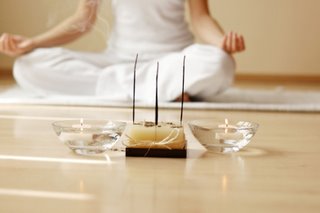 yoga for better sleep Exercise 3
Sit with a straight spine, with the head erect and the chin lightly tucked in. Press the palms together in front of the chest. The fingers of the right hand fingers go over the side of the left index finger and onto the back of the left hand. It is a “cross-lock” with the fingers crossing each other at 90 degrees. Squeeze the hands toward each other with continuous pressure. Begin slow deep breathing as described in Exercise 1. Continue for 2-3 minutes. At the end, inhale deeply and hold with a final push together of the hands for 10 seconds. Exhale, and let your breath relax as you keep your mental focus on the flow of the breath for about 1 minute with eyes closed.
Exercise 4
Sit with a straight spine, with your head erect and chin lightly tucked in. Place your hands in your lap, palms facing up, right hand over the left. The thumb tips touch and point forward. Keep the eyelids half closed. Look downward past the tip of your nose. Inhale in four equal segments through the nose. Mentally recite the sound scale, “Sah Tah Nah Mah”, with one syllable for each stroke of the breath. Then hold the breath by lifting and suspending the motion of the chest. As you hold the breath, mentally repeat the scale four times, for a total of 16 beats. Then exhale in two equal and powerful strokes out the nose. Mentally recite “Wah-Hay” on the first segment out, and “Goo-Roo” on the second stroke out. Continue for 5 to 31 minutes. At the end, inhale deeply and hold for 10 seconds. Exhale, and let your breath relax as you keep your mental focus on the flow of the breath for a few minutes. If you wake up in the night and have trouble falling back asleep, do this exercise for 5 to 11 minutes.
adapted from Body + Soul, April/May 2007
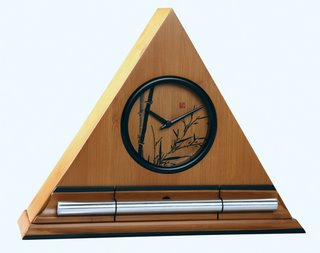 Bamboo Zen Clocks, progressive chime clock and timer for yoga Now & Zen’s Yoga Time & Chime Alarm Clock Shop
1638 Pearl Street
Boulder, CO 80302
(800) 779-6383
Posted in Insomnia, intention, Meditation Timers, mindfulness practice, sleep, Sleep Habits, Well-being, yoga, Yoga Timer, Yoga Timers by Now & Zen
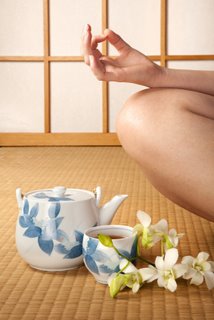 enjoy a meditative cup of tea A meditative act
Many tea drinkers say that drinking tea is not the sole purpose for the ceremony. At the Rocky Mountain Tea Festival, an annual summer event hosted by the Dushanbe Teahouse in Boulder, Colorado, tea professionals from around the country impart information on ceremonies and tea varieties. At the heart of every presentation is the message that the spirit of tea (chado) is intricately linked with simplicity and calmness.
Fellman, a busy woman who values the sense of well-being she derives from tea, strikes a happy medium between a to-go mentality and a traditional tea ceremony by preparing two spots in her home with an electric kettle, canisters of loose tea, and a cup or teapot. Selecting her spots carefully to provide “something nice to rest my eyes on that feels nourishing to me,” Fellman can enjoy a good cup of tea in twenty minutes. When brewing tea, Fellman listens to the water bubble and watches for steam. She looks carefully at the amount of tea used, breathes in the gentle fragrance of the leaves, and waits for the warmth of the teacup to pull the tension from her shoulders. “The mindful process of making a good cup of tea,” she says, “helps me take time to stop and focus.”
It’s no coincidence that elements of tea preparation are reminiscent of meditation. Buddhist monks served tea in places where a rogi, or path, had to be crossed in order to reach the tearoom and, in essence, leave the cares of the world behind. Today, tea drinkers focus on the art of brewing tea to separate themselves from daily concerns.
 time for a meditative cup of tea Tea professionals suggest taking classes to learn the basic elements and history of the tea ceremony. “You can’t read a book and understand it,” says Austin Babcock, a member of the Washington, D.C., branch of the Urasenke Foundation, who likens tea ceremony education to mastering a martial art or learning to play an instrument. “It’s about getting it with your body. It’s an experience.” The Urasenke Foundation, a school of tea that offers classes worldwide, was founded by sixteenth-century tea master Sen no Rikyu, who is credited with establishing tea as a social and spiritual practice.
“There is a Zen quality” to tea ceremony, says Babcock. It creates “a calming, meditative space that allows you to open up your heart to another person. It is a powerful act of sharing . . . and of savoring the moment.”
adapted from Natural Home Magazine, September/October 2002 by Heather Grimshaw
 a Tibetan bowl/gong timer for timing tea Now & Zen’s Mindfulness Clock & Timer Store
1638 Pearl Street
Boulder, CO 80302
(800) 779-6383
Posted in intention, Meditation Timers, Meditation Tools, mindfulness practice, Zen Timepiece by Now & Zen, Zen Timers
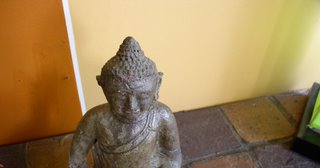 How to meditate Some traditions believe that, to truly practice meditation, you must turn your back on the world: Monks in Thailand live in the woods, hundreds of miles from civilization. Other traditions emphatically state that you must engage in the whole of life, as Buddhist meditation teacher Jack Kornfield attests: “We may start by practicing meditation much like practicing piano. Eventually, when we become proficient, we will not need to practice anymore. Just as playing becomes practice, everything we do will become meditation. In the end, meditation techniques transcend even themselves. Then, there will be neither meditation or non-meditation. Just what is.”
Those disinclined to move into the deep woods, or not far enough along the woodsy path to make every moment a meditation, can create a proscribed area for meditation. While doing this, pay attention to Zen Master Shunryu Suzuki’s advice in his classic treatise, Zen Mind, Beginner’s Mind (Weatherill, 1990): Try to see the space without preconceptions or expectations. As Suzuki puts it,”In the beginner’s mind, there are many possibilities; in the expert’s mind, there are few.” Keep it simple, and make it real.
Our Zen Timepiece’s acoustic 6-inch brass bowl-gong clock is the world’s ultimate alarm clock, practice timer, and “mindfulness bell.”
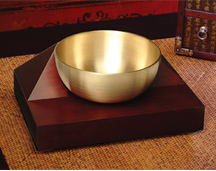 Meditation Timers and Alarm Clocks for a Peaceful End to Your Mindfulness Practice It fills your environment with beautifully complex tones whenever it strikes. It’s exquisite sounds summon your consciousness into awakening with a series of subtle gongs that provide an elegant beginning to your day. Once you experience the Zen Timepiece’s progressive awakening, you’ll never want to wake up any other way.
Our Singing Bowl Meditation Timer also serves as a countdown and interval timer for yoga, meditation, bodywork, etc.; and it can also be set to chime on the hour as a tool for “mindfulness.”
adapted from Natural Home Magazine, November/December 2000 by Kelly Smith
 Singing Bowl Meditation Timer from Now & Zen, Inc. - Boulder, CO Now & Zen’s Meditation Timer & Alarm Clock Store
1638 Pearl Street
Boulder, CO 80302
(800) 779-6383
Posted in intention, Meditation Timers, Meditation Tools, mindfulness practice, Zen Timers
 Awareness As a sustainable communities professor at Dominican University of California, I love to give my students strange assignments and then watch them grow. In turn, they’ve taught me much about coming into the right relationship with life.
Modern living involves high levels of sensory input—much of it meaningless or even nasty. So we shut down. Our magnificent equipment—which allowed our ancestors to feel a shift in the breeze, smell ripening fruit, hear every footfall and see subtle color changes—goes into standby mode. But we need our senses to tell us what we crave (birdsong, sunshine, a gurgling stream, ripe fruit) and what we reject (leaf blowers, smog, clutter). Our senses bring us to life.
So at the beginning of class, I ask students to pause. “Close your eyes, take a deep breath and relax. What do you smell? What do you hear—near, far, steady, intermittent? How does the air feel on your skin—dry, moist, moving, still, cold, warm? Now slowly open your eyes, and notice shapes, colors, light, dark, near, far. What appeals to your senses, and what is a turnoff? What are you aware of now that you weren’t before?”
Suddenly, the students are aware of both the unpleasant and the delicious. They dislike the sounds of traffic, ticking clocks, and mechanical heating and cooling systems. And if there is even one green growing thing, one ray of sunshine or one bird singing, they fall in love with it. In fact, if the weather is decent, they ask, “Can we have class outside?”
Where are you?
At the end of class, I send students home with an expanded assignment: At least once a day, stop and notice how the air feels, where the sun is, the wind’s direction, the terrain, vegetation, critters; then write it all down. This exercise has changed a few lives.
Matt, an urban apartment dweller, realized that he’d been tolerating noise levels that caused tension by day and insomnia by night; he moved, and now he feels like a different person.
Cheryl lives in a suburb and takes the bus to work. She recently began walking to a neighborhood bus stop rather than driving to a central stop, partly so she could spend more time outdoors. She became more aware of trees, birds and weather conditions and more familiar with her neighbors. She noticed that birds were more active and vocal when the sky was clear; she noticed when the geese started flying south and missed them when they were gone. Observing the trees, she noticed the wind’s direction. “The peaceful window of time to myself first thing in the morning helps me start my day with more clarity and calmness,” she says. “And walking home at night, I enjoy gazing at the beautiful night sky and the changing moon.”
Josh lives near the ocean. Sensory tune-ins made him more aware of the breeze, and he wanted to play with it. He put up a wind sock and soon noticed that the wind usually came from the northwest. But why? He explored regional wind patterns, and I encouraged him to study storm fronts and cyclonic wind patterns. Then he bought a little weather station to keep track of wind, air temperature and barometric pressure. After I suggested that he also note his physical and emotional feelings, he had an epiphany: His moods were often directly related to weather conditions.
Cheryl and Josh are beginning to grasp that nature is everywhere and that everything affects everything else. This also has a practical application: They are gaining observation skills that will make them good ecological designers, able to create habitations that are powered by natural elements and friendly to the biosphere.
 balancing rocks In a culture that treats our bodies as isolated machines, it’s world-changing to notice our craving for harmony with other natural phenomena—and starting to learn how to satisfy it. Getting outdoors, listening to our bodies, watching birds, tracking breezes and cycling with the sun are enjoyable in themselves, but they lead us to something much larger: an understanding of how the world works. And once we get it, there’s no going back. The insights keep multiplying, and we’re motivated to greater and deeper actions by feeling truly, deeply alive.
As my student Brian says, “When I stop everything and sit as part of it all, I feel the connection rather than intellectualizing interconnectedness.” Because everything is interconnected, we can start our journey anywhere, with deceptively simple steps: stop, look, listen, feel.
 Singing Bowl Meditation Timer from Now & Zen, Inc. - Boulder, CO The Zen Timepiece (with Tibetan- Singing Bowl) serves as a countdown and interval timer for yoga, meditation, bodywork, etc.; and it can also be set to chime on the hour as a tool for “mindfulness.”
adapted from Natural Home Magazine, September/November 2009 by CarolVenolia
Carol Venolia is an eco-architect and co-author of Natural Remodeling for the Not-So-Green House (Lark Books, 2006). She teaches in the Sustainable Communities program at Dominican University of California.
 Chime Meditation Timers and Clocks with Chime in Bamboo, Walnut, Maple, and Black Lacquer Now & Zen’s Meditation Timer & Alarm Clock Shop
1638 Pearl Street
Boulder, CO 80302
(800) 779-6383
Posted in Insomnia, mindfulness practice, Natural Awakening, nature, Well-being
 walking in waves, a mindfulness meditation There is nothing more soul-renewing than a very long, meandering, aimless walk. And I do mean aimless — as in, “I’m heading out! I have no idea how long I’ll be or where I’m going!”
I started walking this way quite by accident, in the midst of recovering from the heartache and confusion of losing my job. I had been slothful through winter, alternating between insomnia and sleeps so deep I wasn’t sure what day it was when I woke. But with the changing light of spring, I was beckoned out of doors.
Finding Peace Amidst the Chaos
I was in Manhattan, and cities are excellent places for meditative walks. They’re full of interruptions and distractions, but there is always a bus stop or a person with directions within easy distance. So you can suspend the anxiety about getting lost or getting home.
And all that noise does for humans what shape does for bats: Even if we aren’t tuning into it, it guides our steps and signals danger or direction.
A city walk also delivers the pleasure of unexpected architectural discoveries: trolls clinging to the corners of buildings, swags of flowers carved into stone friezes.
These days I’m walking in the country, in coastal Rhode Island, where the blackbirds and foxes keep me company.
“Exploring the world is one of the best ways of exploring the mind,” writes Rebecca Solnit in “Wanderlust: A History of Walking.” The mind eventually begins to follow the feet, and a logjam of anxiety starts to come loose.
 Soul-Renewing Walking Meditation From Type A to Point Be
Long walks are the cure for writer’s block, lover’s block, mother’s block, friendship block, and any other kind of obstacle that we try to deliberately gnaw our way through, worrying over the problem and getting nowhere.
Better to let yourself really go nowhere and experience the delicious paradox of losing yourself to find yourself.
Walking with indirection has, at heart, a paradoxical benefit. When you stop making decisions for a little while, before you know it, you are filled with purpose, and the goals and paths of your life take on a new clarity.
It is by such grace that life unfolds; how lovely to suspend disbelief (I will never feel good again) and arrive at conviction: Life is wonderful! What a joy to be moving!
How-To: Walking as Meditation
1. Focus on your breathing. Paul Smith, walking-meditation instructor at Lake Austin Spa Resort in Austin, Texas, recommends inhaling slowly through your nose for 4 steps, keeping your breath in for 2 steps, exhaling for 4 steps, then waiting 2 steps before inhaling again.
2. Gently corral your wandering mind. Try repeating an affirmation in time with your breathing and steps. Smith recommends phrases such as “My life is a pleasure,” “I speak the truth and listen without judging,” or “I see all things in clarity.” Another trick: Visualize putting your worrisome thoughts in a balloon and letting go of the string.
3. Hold one hand behind your back. This will help slow you down. “Don’t let yourself get into race-walking mode,” Smith says.
4. Pay attention to your senses. Focus on vision first, which is easiest. Notice a plane overhead, leaves in the trees. Then notice sounds around you, the sun on your face, the smell of cut grass. Smith says, “These are ways to stay in the present.”
5. On a practical note: If you’re walking for distance, carry a little “mad money” in case you tucker out miles away. But no cell phone — or turn it off if you must have it on you.
adapted from Wholeliving.com, September 2010 by Dominique Browning
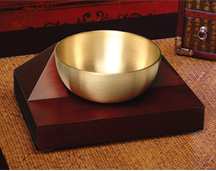 Singing Bowl Meditation Timer & Alarm Clock
Our Zen Timepiece’s – (a Singing Bowl Meditation Timer) acoustic 6-inch brass bowl-gong clock is the world’s ultimate alarm clock, practice timer, and “mindfulness bell.”
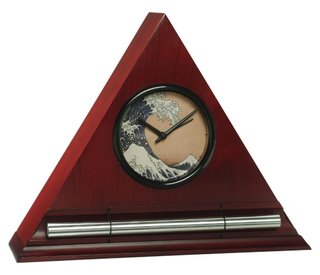 Hokusai Wave Zen Meditation Timer and Alarm Clock Now & Zen – The Meditation Timer Store
1638 Pearl Street
Boulder, CO 80302
(800) 779-6383
Posted in Chime Alarm Clocks, Hokusai Wave, intention, Japanese Inspired Zen Clocks, Meditation Timers, Meditation Tools, mindfulness practice, nature, Walking Meditation, Well-being, Zen Timers
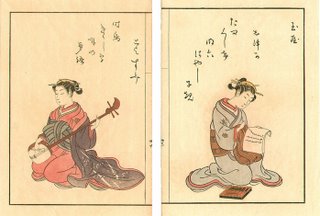 Shamisen and Letter by Harunobu 1. Spirituality
Experience your spirituality as a gift and a process.
2. Compliments
Don’t shrug off compliments; honor and remember them.
3. Experiences
Invest in experiences, not just objects.
4. Grace
Try doing even the most menial tasks mindfully and with grace.
5. Compassion
Anger has a way of evaporating in the face of compassion.
6. Calm
Calm is a place you create in the midst of chaos.
7. Simplicity
There’s no substitute for simple pleasures.
8. Laughter
Laugh a little — every day.
9. Physical
The spiritual and the physical cannot be separated; you need one to experience the other.
10. Pleasure
Find pleasure in the simplest tasks.
 Zen Clocks with Chime from Boulder, CO adapted from Body + Soul Magazine, 2009
Now & Zen – The Zen Alarm Clock Shop
1638 Pearl Street
Boulder, CO 80302
(800) 779-6383
Posted in Meditation Timers, Meditation Tools, mindfulness practice, Well-being
 Mantra Meditation: Utamaro Kitagawa, The Courtesan Hanaogi of Ogiya Mantra Meditation
What is it?
Mantra meditation utilizes the power of sound and vibration to create stillness in the body, calm the nervous system and ultimately transform the mind. The words typically come from ancient spiritual languages, such as Sanskrit or Gurumukhi. The sacred meanings of the words enable you to establish a connection to profound truths that have been spoken for thousands of years, explains Krishna Kaur, a kundalini yoga teacher since 1970 and founding member of the International Association of Black Yoga Teachers (blackyogateachers.com).
What’s it good for?
Because each mantra differs in its meaning and vibrations produced, you can select mantras to create specific effects— such as increasing mental clarity, developing intuition, or reducing anger and stress. Kaur suggests starting with the simple mantra sat nam because it’s easy to say and remember, yet offers profound effects. Sat translates as “truth,” and nam as “identity.” This mantra helps you identify with a universal spiritual truth in which such transient emotional states as fear, anger and doubt fall away.
How long does it take?
Start with three to five minutes, increasing by a minute at a time until you can sit and chant for a full 11 minutes.
 Meditation How do I do it?
1. Sit comfortably in a chair or on the floor with your spine straight to help your breath and the sound it creates flow smoothly. Close your eyes and bring your attention to your breath for a moment to get centered.
2. Take a long, deep inhalation through your nose. As you exhale, utter an extended sat (pronounced “sut”) to almost the end of your breath, followed by a short burst of nam (“nom”). Together, the mantra will sound like “saaaaaaaaaaat nam.”
3. Inhale slowly and evenly, then repeat the mantra as you exhale. Continue this pattern.
4. At the end of your session, inhale and hold your breath for a few seconds, then exhale through your nose. Do this three times, then sit quietly for a moment and feel the energy flow through your body. Open your eyes, stand slowly and carry your sense of calm and clarity with you.
Although meditation can be done in almost any context, practitioners usually employ a quiet, tranquil space, a meditation cushion or bench, and some kind of timing device to time the meditation session. Ideally, the more these accoutrements can be integrated the better. Thus, it is conducive to a satisfying meditation practice to have a timer or clock that is tranquil and beautiful. Using a kitchen timer or beeper watch is less than ideal. And it was with these considerations in mind that we designed our digital Zen Alarm Clock and practice timer. This unique “Zen Clock” features a long-resonating acoustic chime that brings the meditation session to a gradual close, preserving the environment of stillness while also acting as an effective time signal. The Digital Zen Clock can be programmed to chime at the end of the meditation session or periodically throughout the session as a kind of sonic yantra. The beauty and functionality of the Zen Clock/Timer makes it a meditation tool that can actually help you “make time” for meditation in your life.
adapted from naturalhealthmag.com By Frances Lefkowitz
 Bamboo Gong Meditation Timer and Alarm Clock Now & Zen, Inc.
1638 Pearl Street
Boulder, CO 80302
(800) 779-6383
Posted in Meditation Timers, Meditation Tools, mindfulness practice
« Previous Page — « Previous Entries
Next Entries » — Next Page »
|
|
|
|